U2 Takes to Playing in the Round (the Very, Very Round) at Las Vegas’ Sphere With Spectacular Results: Concert Review
- Oops!Something went wrong.Please try again later.
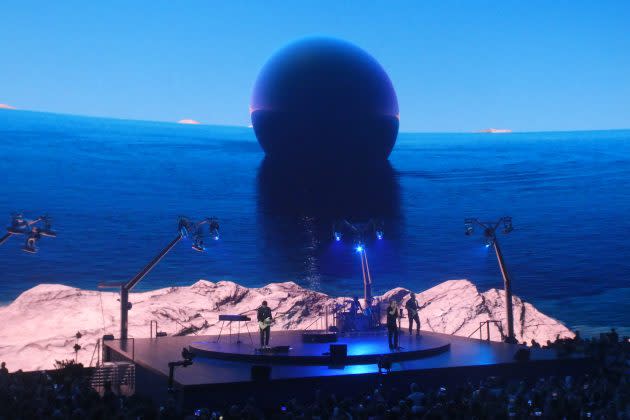
Spectacle is underrated.
This is pretty much the antithesis of any accepted, traditional rock ‘n’ roll orthodoxy. It is also the natural human reaction to just about any or all of “U2:UV Live at Sphere Las Vegas,” the greatest-show-on-earth that opened Friday night in an enormous dome just off the Strip. The just-over-two-hour show marks the apotheosis of a bigger-is-better ethos that has regularly occurred throughout the band’s career, and which they are not about to give up now that they’re in their 60s for any back-to-basics false modesty. The group that has spent so much of its recording output urging you to think about God, and other only slightly less weighty matters, is in Sin City mostly to make you say: “Oh my God.” And we can vouch that we were hearing that utterance, from people above, below and around us, in a kind of reactive, quadrophonic effect that nearly matched Sphere’s vaunted 22nd-century sound system.
More from Variety
This being U2, they would also like to be seen as an overgrown club band at their core, as the same time they are producing the rock blockbuster to end all blockbusters. Wanting to have it both ways has worked for the group before, and it works again, in this setting. At times, the overpowering overhead visuals are either turned off completely or reduced to a simple single (or quadruple) live image hovering gently and unobtrusively over the stage. And these parts of the set work wonders, too… although even then, there is an extreme cleverness to the utter simplicity of the stage they’re on that almost seems like its own special effect. It’s a cliche to say that U2 can achieve intimacy in the midst of the most ridiculous extravaganza, but nobody in rock history has done a better job of taking visual and aesthetic dynamics to extremes. That hasn’t changed now that the band is playing in the round… really, really, really, really in the round.
But obviously it’s the audacious hugeness, not the Let’s Get Small interludes, that “U2:UV” will most be remembered for. It is, at its giddy and delirious best, a slide down the surface of things, to recall a prophetic phrase that might have foretold the very existence of Sphere, a venue that invites you to spend a half-hour at a time thinking or talking just about its interior and exterior surfaces, including a ceiling that reaches to 366 feet tall. These surfaces feels like they should be measured in square miles, not square feet, but U2 does not feel dwarfed in their glow.
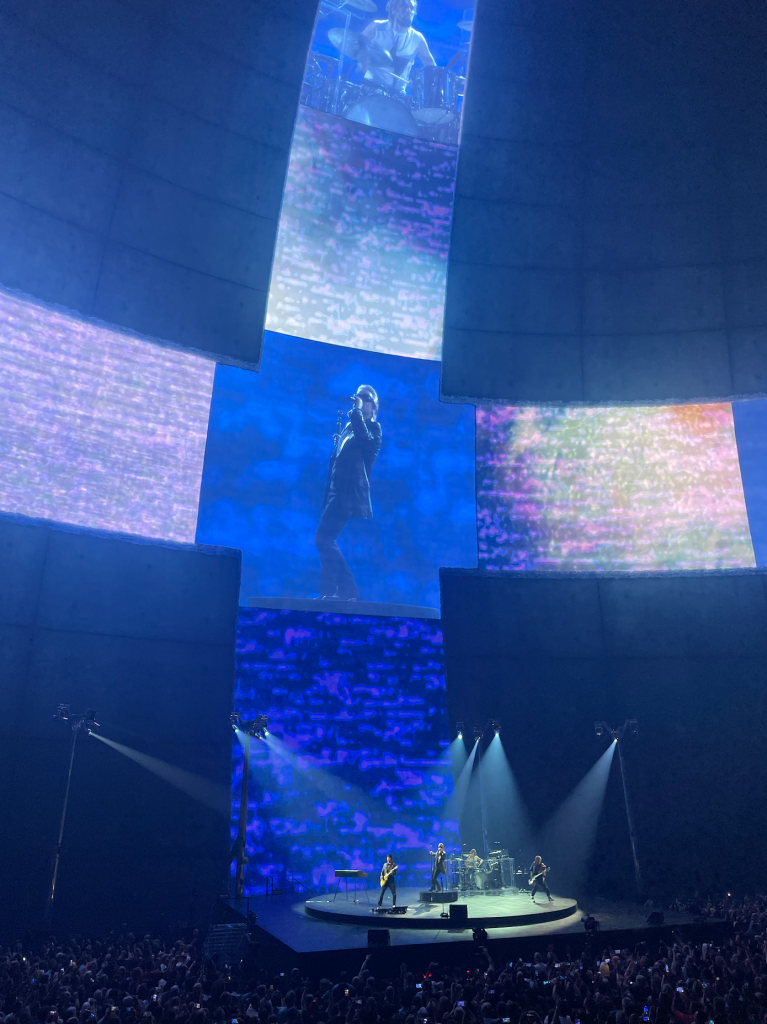
“Who spiked your drink?” Bono asked the crowd early on. It was a rhetorical question, but the answer is, Willie Williams did. He is the creative director of 40 years standing now for U2, and he’s outdone himself with a series of settings — some directed by him, some outsourced to amazing digital artists like Es Devlin — that blow your mind, then give it a helpful rest, and then return for further sensory overload at the end. None of these visuals are ever in much of a rush, with the exception of one setpiece lifted from the original Zoo TV tour that is actually about overload, with printed slogans passing across the big screens faster than you can take them in.
Apart from that one bit, Williams knows that your brain has to take a while to take anything, so you never feel like you have to close your eyes to give yourself a break. But it is heady, especially in one of the first numbers, “Even Better Than the Real Thing,” which has a flow of pop and film imagery that includes a lot of shots of Elvis Presley and Frank Sinatra, embedded in an ornate, almost Hindu-temple-like tapestry. Look carefully during that segment, and you will see the recurring image of Dennis Hopper’s Frank Booth in “Blue Velvet,” huffing on whatever he was huffing on in that movie. You may know a little bit now how jacked-up Frank Booth feels, minus the malevolence.
Not to take any credit away from U2, but the most impressive moment of the Sphere show may be when you first walk in the room. And that happens on two levels, literally. Above you, that massive domed ceiling has been made to look like you are in some industrial grain silo that has been constructed sky-high. (One seatmate described the feeling of looking up at this while waiting for the show to begin as “terrifying… but not in a bad way.”) It’s an immediate indication of some of the offbeat photorealism you will be in for. But at the same time, if you’re on one of the lower levels of the multi-tiered auditorium, looking out over the general-admission SRO floor, and block out what’s hovering over you (which is surprisingly easy to do), you suddenly feel like you’re in the world’s coolest nightclub. Or at least mega-club; at or slightly above floor level, it kinda just feels like the Hollywood Palladium, albeit with more of the audience wrapped around the sides of the stage.
Or, in the comparison Williams brought up in an interview with Variety, “Being on the floor is going to be quite something. It feels so small. I was laughing with Adam because we both for some reason thought of Hammersmith Palais.” That’s the kind of analogy people bring up when they’re trying to convince you that their mega-show has some kind of real human scale to it… but damn it, he didn’t lie.
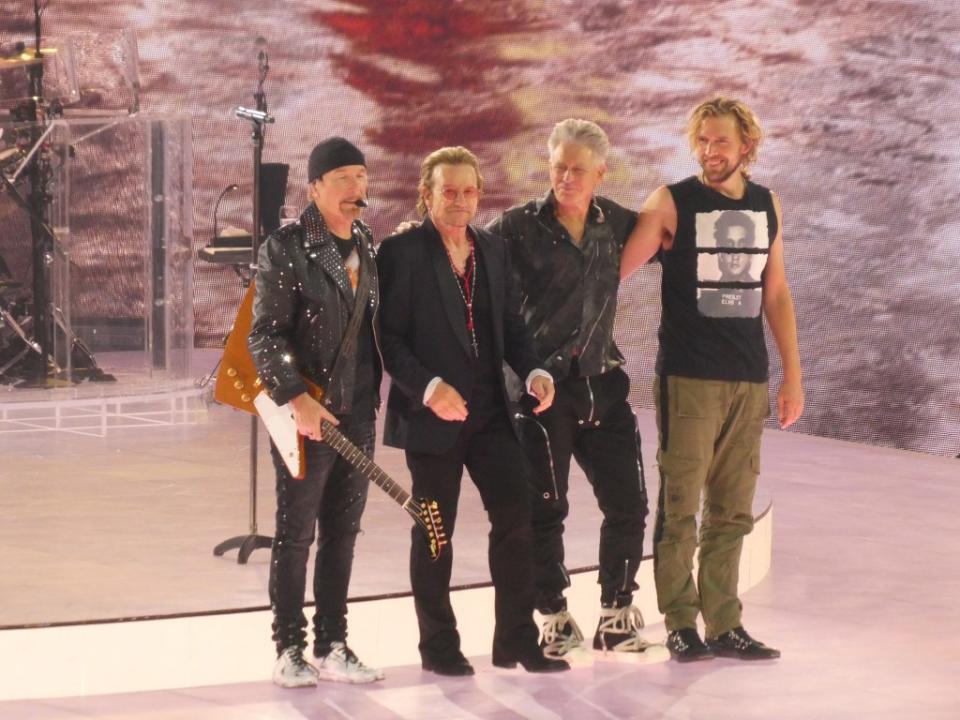
Every one of the hundreds of thousands of LEDs in the place could short out and it would still be a visually impressive show, just because of the utterly austere but beautifully sleek stage design. A giant “turntable” designed by Brian Eno (don’t worry, the band doesn’t actually spin) has virtually nothing on it except the four band members, their instruments and four tiny monitors; it almost seems unreal that there could be that little on stage. And when the overhead lights go out and the turntable just glows a soft blue or pink, it is a little bit like staring at a state-of-the-art record player in the dark, except for the animated figurines on top.
But certainly Williams and the band don’t intend for you to spend very much of the show thinking about how cool minimalism is… just the middle part. It has been front-loaded, and to a lesser extent backloaded, with crazy-ginormous effects. As Williams said in his Variety interview, he knows the human mind adjusts quickly and even the most mind-expanding stuff can seem normal after about a half-hour, so those first 30-50 minutes include most of the wildest stuff in the production. There’s one segment where the video screen turns this cornerless room into a rectangularly shaped space, and you can only guess at how the designers had to bend the laws of physics to create that illusion on a circular screen. The most jaw-dropping moment of the night, arguably, comes when you look straight up and see what appears to be an elevator made up of data descending down toward you. It can only be described as a very slow-motion, more abstract version of the chandelier dropping in “Phantom of the Opera.”
The only other visual bit that requires you to crane your neck actually involves the show’s one use of a practical, versus purely digital, effect. During “Who’s Gonna Ride Your Wild Horses” (which lyrically, as you may recall, invokes Jacob’s ladder), what looks like an endless series of sheets tied together rises toward the peak of the dome. At first it’s not clear if this is another screen image, but the sheet-ladder is real, and it’s spectacular, as it connects to an animated balloon up in the heavens. Bono then invited a young woman on stage to “walk” the balloon around the stage, and eventually to go for a swing in a loop that was formed at the bottom. It was just weird-ass, and also completely lovely.
Other visual motifs tended to be more stationary, and face-forward for the audience: images of flags, made up of fire or smoke; a field of dotted white lights that could have been an abstract cityscape, or maybe a field of electric poppies; undulating ripples on water. Sometimes live images of the four players (including guest drummer Bram Van Den Berg) were projected large-scale, but sometimes their visages were tiny, floating bubbles in a vast visual sea, like a picture-in-picture effect. The finale of the “Achtung Baby” section(s) turned the dome into a beautiful solid blue, before that screen began to be blotted out, little by little, by giant bees and flies, until it was almost completely blacked out by bugs. (Love is blindness, indeed.)
The inevitable live premiere of the new single, “Atomic City,” brought the outside inside, in an audacious way: The streets outside the Sphere were projected onto the interior, in what almost looked like it could be a real-time live feed, before it became clear that it was pre-recorded when the cityscape gave way to the nearby barren desert. The bulk of the show doesn’t rely much on outdoor photography so much as more abstract visuals; Williams made it clear that he was leaving nature cinematography to Darren Aronofky, whose “Postcard From Earth” travelogue film will debut in the venue shortly. But when Williams did deign to let the dome go “outside” near the end, its potential to create the illusion of abject reality was about as cranium-blowing as any of the more psychedelic effects seen earlier.
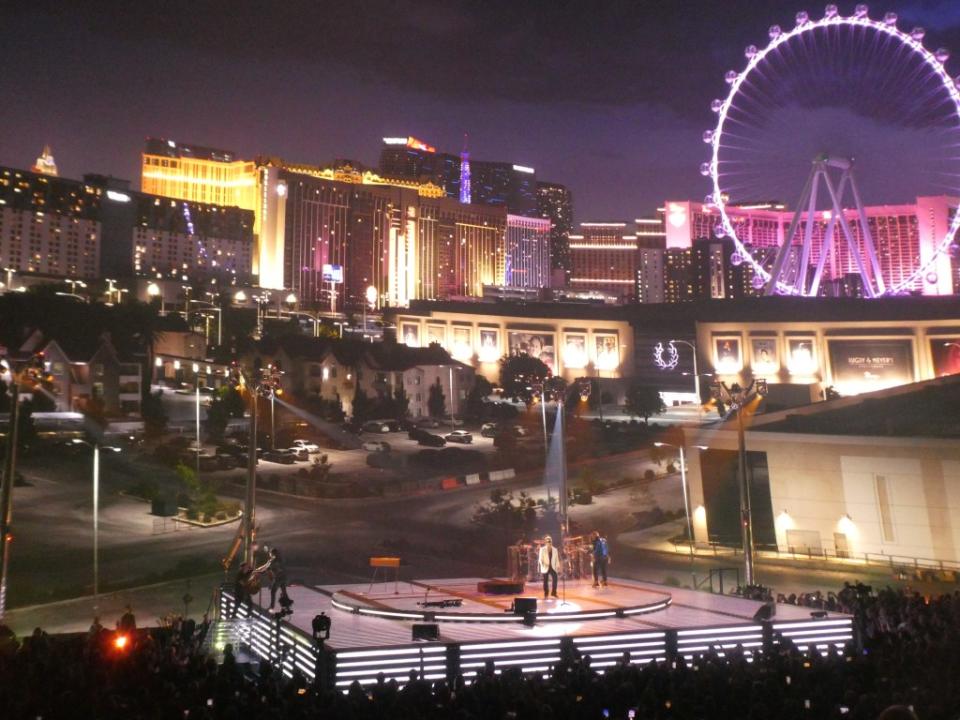
And yet, for all that, when I think back on highlights of “U2:UV,” I’ll think of the band thundering its way through “Acrobat,” one of the least-played or least-celebrated “Achtung Baby” songs, with nary a special effect in sight. We haven’t talked much about the music yet, which is an inevitable byproduct of what Sphere brings to the table as this show’s real raison d’etre. But an “Achtung Baby”-based show was overdue, for those of us who consider it the band’s very greatest album, however inevitable it might have been that “The Joshua Tree” was the one that the quartet toured around the world for a few years in a retrospective show in 2017-19. The biggest joy of this residency is… well, fine, the spectacle of the thing, but the second-biggest joy is getting to hear some of those deeper “Baby” tracks, to which attention must also be made. The opening of the Sphere show features the eight tracks from that 1991 LP everyone most knows and loves — it’s practically a one-album greatest-hits set unto itself — but isolating the less famous final four into a separate segment near the end provides a portion of the show that will feel especially rewarding for the group’s most faithful fans. Hearing the Edge go to town with extended soloing on that album’s closer, “Love Is Blindness,” is a treat that’s been denied a reprise for too long.
As previously noted in a story recapping the first night’s setlist, there is a midpoint portion of the show, interrupting the two “Achtung Baby” segments, that seems as if it will be designed to be U2’s equivalent of Taylor Swift’s nightly “secret songs” segment. And it’s this bit of the show that will give anyone who is even fortunate enough to be catching it on another night a good case of FOMO, as Bono indicated they will use it to showcase a different album from their catalogue each evening. (There are 25 shows in the residency, and definitely not that many U2 catalog albums to go around, so only time may tell exactly what the rotation entails.) On opening night, seemingly as a nod to producer Jimmy Iovine being in the house, the four songs in that segment were all from “Rattle and Hum.” All were played in a semi-acoustic format (basically, with the Edge playing acoustic guitar; they didn’t make the new drummer play with brushes or anything). Bono introduced “Angel of Harlem” as a song they stole from Bob Dylan, and if it wasn’t immediately clear what he meant, it quickly became so when the Edge started strumming what basically amounted to the acoustic guitar riff from “Tangled Up in Blue” to start off the number.
Elsewhere in the set, Bono talked about stealing from the Beatles — a nod to Paul McCartney being in the audience, which the band celebrated by tagging bits of “Love Me Do,” “Sgt. Pepper’s Lonely Hearts Club Band (Reprise)” and “Blackbird” onto the ends of songs, something that presumably will not carry over into night 2. These Fab fragments felt pleasingly random enough, yet Bono tied it all together when he gave a brief speech about how Sphere creator James Dolan was using the sophisticated sonics invented for this venue to solve a problem that the Beatles created when they played Shea Stadium in 1964 and no one, the band included, could hear a thing.
How phenomenal is the sound in Sphere? It’s tempting to want to go back and sit in the back row to find out, but at the 100s level, at least, it was more wonderful than anything we’ve ever heard in an 18,000-capacity venue. And considering that even Dolan has acknowledged that dome-shaped buildings intrinsically have the shittiest sound of all, that’s saying something. Sphere’s team of inventors have created a system that micro-targets concertgoers wherever they’re sitting, and a demo that was done for journalists showed how it is even possible to make it so that patrons sitting three seats apart could hear a lecture in different languages, with no bleed-over. There is no use for that particular audio stunt in a U2 show (the “uno, dos, tres, quatro” count-off Bono does at the beginning of “Vertigo” was not translated into English anywhere in the auditorium). But the most basic goal, of offering studio-quality sound on a massive scale, seemed to have been met.
Bono did not get sentimental much, during the show — it was a time of mirth, with no retrospective talk about the “Achtung Baby” era or the album itself, which was more or less just treated as if it were the band’s new album. But he did get choked up when he name-checked Jimmy Buffett — “Everybody knew him,” the singer explained, whether we’d ever imagined Bono chilling out on a fishing yacht or not —and offered a dedication to the family, friends and doctors of the late Jimmy Buffett, whom he said were all in attendance, checking them off by name. “Fuck, it’s hard to say goodbye to somebody,” he said. Implicit in these shows, with Larry Mullen Jr. temporarily out of the picture for recovery from surgery (but mentioned repeatedly during the concert), is that we may not be privy to these kinds of shows, at this level of vigor, forever, even if it seems like the 30-plus years since Zoo TV have passed in the blink of an eye.
It may seem corny to say that a big sphere could make you think about the Big Picture. But the show saved its possibly its best audio-visual moment — definitely not its trippiest or most elaborate, but its most beautiful — for last: a design by Es Devlin that had a nearly Michelangelo-esque tapestry of still-life flora and fauna taking over the wrap-around screens, while the band performed a closing “Beautiful Day,” after a brief mention by Bono of how all God’s creatures need to be considered among changing temperatures. As the crowd exited, Devlin’s design was projected on the exoskeleton of Sphere just as it had been on the interior… a canny instance of bringing the inside outside, after the opposite had been achieved earlier. For all the “2001”-recalling graphics seen on the exterior of Sphere during other moments, this one was a reminder that mortal life itself is the ultimate trip.
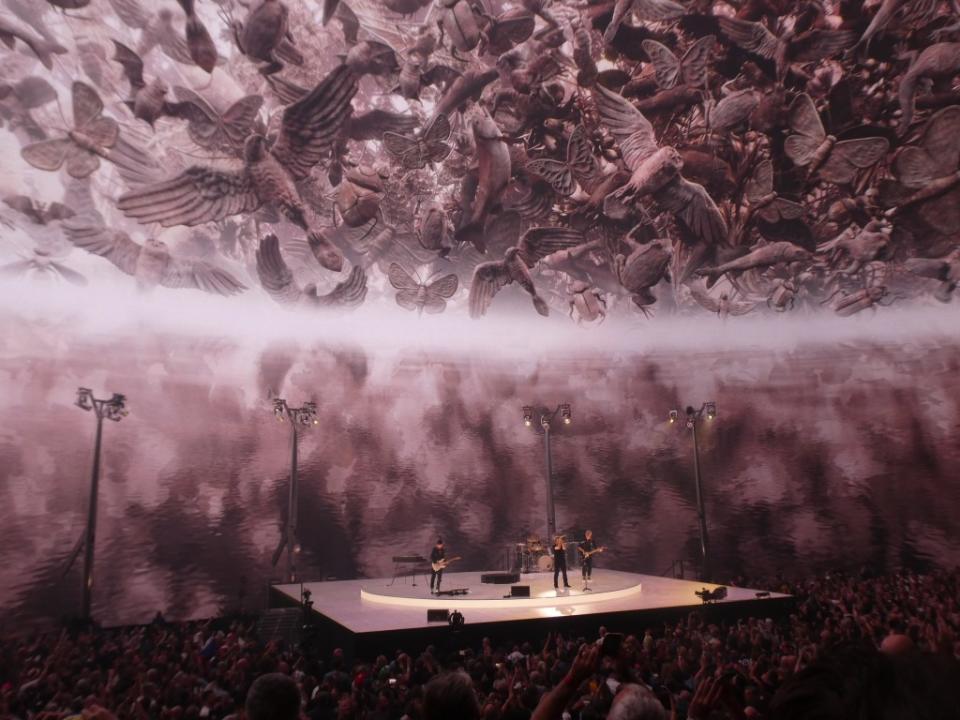
Against many odds — of age, of personal change, of shifts in attitude about authenticity and delusions of grandeur — “U2:UV” does come off managing to feel like actual rock ‘n’ roll. It also feels like Circus Circus marrying some kind of foreign-film aesthetic. With all the heart and soul and silliness and grandiosity appropriate to the host city, this might be the best shotgun wedding Las Vegas ever presided over.
Best of Variety
Sign up for Variety’s Newsletter. For the latest news, follow us on Facebook, Twitter, and Instagram.

